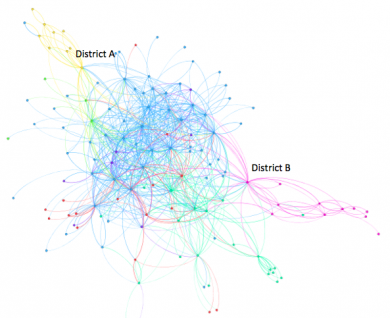This summary presents preliminary findings from recent network research in Ghana. These are shared to engage a broader community in current research, and should not be taken as firm conclusions. Questions, comments, and feedback are greatly appreciated.
Published on: 19/08/2015
This is part of PhD research through the Cambridge University Centre for Sustainable Development, and an expanded description of the research is available here. The research seeks to understand networks of stakeholders in rural water sub-sectors, and what about these environments helps institutions managing rural water service delivery to improve.
In addition to piloting research methods, the study had two aims:
The network focused around East Gonja and Akatsi, and their respective regional and national levels. These two districts are examples of positive change where authorities managing rural water service delivery have demonstrated improvements as assessed by the Triple-S initiative.
Data collection involved individual interviews with key stakeholders. These participants draw networks of who they interact with and how in the rural water sector. Link types included information, skills, power, and resources, each containing sub-categories with different levels of strength. Following the network drawing exercise, participants were asked to comment on network aspects that are helping services to improve. Recommendations of interviewees informed follow up interviews until all key stakeholders were included.

In total, 43 interviews were conducted across four regions, involving participants ranging from communities to ministries.
Networks were then analysed, along with participant perspectives on network dynamics, to identify themes that may be supporting institutional improvements for managing rural water service delivery.

The combined network produces a graph of sector interactions in Ghana’s rural water sector. It links national level interactions to regional ones, and then to the two case study districts and their local environments.
Many types of analysis are possible within this network. Participant commentaries on important network dynamics were coded to identify themes that were then investigated in the network. Combining these two types of analysis identified four overall themes that appear to coincide with cases where management of service delivery is improving:
These are themes, not necessarily causes, which coincide with institutional improvements. Specific causes are difficult to identify because of the multitude of coinciding influences. These themes, however, help to characterise dynamics in this sub-sector that may be supporting institutional development. Each theme is supported by more detailed observations of specific network dynamics, or commentary on the network provided by participants. For example, filtering network linkages can highlight the specific role that a district plays in a local information network.

Firstly, this case study demonstrates the feasibility of the research methods to produce an overall sector network map by combining individual stakeholder perspectives. This network can then be analysed from many angles to explore a variety of hypotheses. These methods also allow for the verification of perspectives against each other, and ensure that individual perspectives are not marginalized or influenced as they might be in group settings. There may be potential to apply these methods to other sub-sectors, or to explore more specific hypotheses, in the future.
Secondly, these preliminary themes identify dynamics that may be contributing to service delivery improvements. These themes may help sub-sectors understand favourable conditions to look for when interpreting whole networks. These findings are preliminary, however, and may be unique to the Ghanaian context. Subsequent research will look at other countries in Africa, Asia, and possibly South America to see if there are common themes across different contexts.
This research is tailored to institutional development in the rural water sector, but the methodology could have broader applications, such as:
Research is continuing in Malawi as a second country case study through July and August 2015. Findings will be analysed using the same methods applied in Ghana to identify emergent themes. These themes can then be compared to findings from Ghana, but the methods will still allow for different, and even conflicting themes to emerge. Findings from this next case study will also be shared when they become available.
Feedback, questions, and comments are greatly appreciated. They help to the quality of the research and its applicability.
At IRC we have strong opinions and we value honest and frank discussion, so you won't be surprised to hear that not all the opinions on this site represent our official policy.